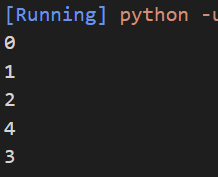Node dequeued using the pop left method the deque object
PEAS representation
Performance measure – The performance measure for the intelligent pipe flaw detection robot would be its ability to accurately detect and locate flaws in pipes. This could be measured by the percentage of flaws detected correctly, and the overall efficiency of the robot in detecting flaws.
Based on the Peas representation a goal-based agent would be the most suitable type of agent for the intelligent pipe flaw detection robot. This is because the goal of the robot is to detect and locate flaws in pipes and a goal-based agent is designed to achieve specific goals based on its current state and environment.
Reasons
Furthermore, a learning agent can also be useful for the intelligent pipe flaw detection robot as it can adapt and improve its performance over time based on feedback and experiences. The robot could learn to recognize different types of flaws and adjust its goal and action accordingly. This ability to learn would allow the robot to continuously improve its performance and become more accurate in detecting flaws.
In contrast, a simple reflex would not be suitable for the pipe flaw detection robot as it would only be able to react to the immediate environment without considering the overall objective of detecting flaws. A model-based agent could be useful, but it would require an accurate and up-to-date model of the pipe system, which could b changed to maintain. A utility-based agent could be useful, but it would require the definition of the utility functions which may be difficult to define in the context of pipe flaw detection.
Ans – To find this answer in the above table.
= 1/6
= In-detail answer
$$\frac{1}{6} + \frac{1}{12}$$
P(X=2) = 1/6 + 1/12 = 1/4
P(X=3) = 1/12
P(Y=3) = 0 + 0 + 0 + 1/12 = 1/12
Give the conditional probability function for X given Y=1
P (X=2 | Y=1) = 0 / 1/4 = 0
P (X=3 | Y=1) = 1/12 / 1/4 = 1/3
First, we calculate the marginal probability.
P(X=0) = 1/4, P(X=1) = 1/3, P(X=2) = 1/4, P(X=3) = 1/12
P (X=0, Y=2) = (1/4) x (1/3) = 1/12 ≠ P (X=0, Y=2) = 1/12
P (X=0, Y=3) = (1/4) x (1/12) = 1/48 ≠ P (X=0, Y=3) = 0
P (X=2, Y=0) = (1/4) x (1/12) = 1/48 ≠ P(X=2, Y=0) = 0
P (X=2, Y=1) = (1/4) x (1/4) = 1/16 ≠ P(X=2, Y=1) = 1/12
P(X=3, Y=2) = (1/12) x (1/3) = 1/36 ≠ P(X=3, Y=2) = 1/12
P(X=3, Y=3) = (1/12) x (1/12) = 1/144 ≠ P(X=3, Y=3) = 0
Ans – In this question, I have implemented the state space graph with the help of Python and solved the problem of the BFS like the breadth-first search method. To create this code with the help of the above graph
I have an explanation of the Breadth-first search method.
First, the function takes two arguments: graph, which is a dictionary representing the adjacency list of the graph, and start, which is the starting node for the search.
Inside the function, visited is a set that keeps track of visited nodes, while the queue is a deque object that acts as a queue to store the nodes to be visited.

Explanation of output
